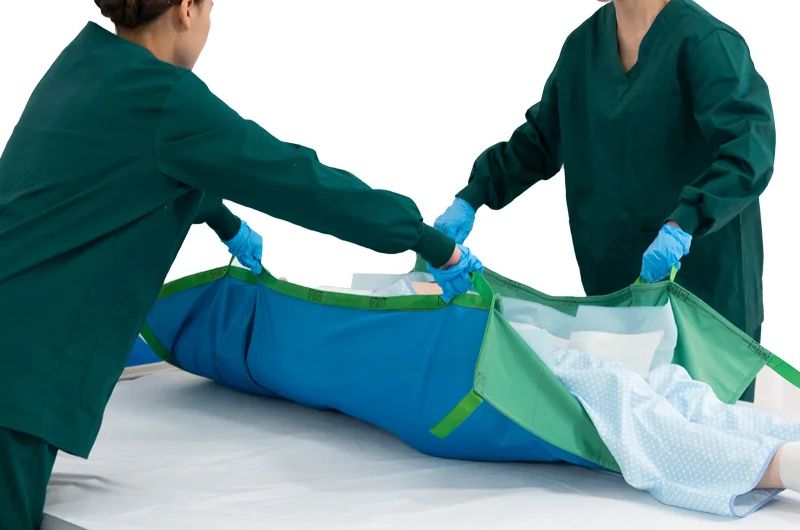Healthcare professionals are dedicated to caring for others, but the demanding nature of their work often puts their own health at risk. Patient handling, in particular, is a leading cause of musculoskeletal injuries (MSIs) among nurses, CNAs, therapists, and other healthcare staff. These injuries can lead to chronic pain, missed workdays, and even end careers. While comprehensive safe patient handling programs are essential, one seemingly simple tool plays a key role in preventing these injuries: the transfer sheet. This post will explore the vital contribution of transfer sheets to protecting healthcare worker occupational health by significantly reducing the risks associated with manual patient handling.
1. The Cost of Patient Handling: An Occupational Hazard for Caregivers
The repetitive and physically demanding tasks of lifting, transferring, and repositioning patients expose healthcare workers to significant forces that can lead to serious injuries. Common injuries include:
- Lower Back Injuries: Often caused by bending, twisting, and lifting heavy loads.
- Shoulder Strains and Rotator Cuff Tears: Resulting from pulling and lifting with the upper body.
- Neck and Upper Extremity Pain: Associated with awkward postures and repetitive motions.
- Hernias and Other Musculoskeletal Disorders: Caused by excessive physical exertion.
These injuries have far-reaching consequences, including:
- Pain and long-term disability for the caregiver.
- Absenteeism and staff shortages, impacting patient care.
- Increased workers’ compensation costs for healthcare facilities.
- Decreased staff morale and increased turnover.
2. Transfer Sheets as a Primary Injury Prevention Tool
Transfer sheets are made from low-friction materials that are placed under a patient to facilitate movement with minimal resistance. This simple mechanism is incredibly effective in reducing the physical forces that lead to caregiver injuries:
- Reducing Friction and Shear: The slick surface of the transfer sheet drastically reduces the friction between the patient and the bed or stretcher. This means caregivers don’t have to use as much force to initiate or complete a transfer or repositioning task. Reducing shear also protects patient skin, which indirectly benefits caregivers by minimizing the need for complex wound care that can involve awkward postures.
- Minimizing the Need for Heavy Lifting: Instead of attempting to lift the patient’s full weight, caregivers can utilize the transfer sheet to slide or glide the patient laterally. This shifts the task from a high-force lift to a lower-force sliding motion, significantly reducing the load on the caregiver’s musculoskeletal system.
- Facilitating Easier Repositioning: Even small adjustments to a patient’s position in bed, which are performed frequently, become less physically demanding when a transfer sheet is used to reduce friction. This cumulative reduction in strain throughout a shift is crucial for preventing fatigue and chronic injuries.
3. Promoting Ergonomic Principles in Practice
Transfer sheets don’t just reduce force; they also make it easier for caregivers to apply proper ergonomic principles:
- Encouraging Better Body Mechanics: When less force is required, caregivers can more easily maintain proper body mechanics, such as bending their knees and hips and keeping their backs straight.
- Reducing Awkward Postures: The smooth movement facilitated by the transfer sheet minimizes the need for caregivers to twist, reach, or maintain awkward postures during transfers, further protecting their spines and joints.
- Enabling Coordinated Teamwork: Transfer sheets simplify coordinated movements when multiple caregivers are involved, allowing for a more synchronized and ergonomically sound approach to patient handling.
4. Transfer Sheets as Part of a Comprehensive Safe Patient Handling Program
While transfer sheets are powerful tools, they are most effective when integrated into a comprehensive safe patient handling and mobility (SPHM) program. Such programs typically include:
- Risk Assessment: Evaluating patient needs and transfer requirements.
- Training: Comprehensive training on proper body mechanics, the use of assistive devices (including transfer sheets), and specific transfer techniques.
- Equipment Availability: Ensuring appropriate assistive devices, including transfer sheets, are readily available in all patient care areas.
- Policy and Protocols: Clear guidelines and policies for safe patient handling practices.
Within this framework, transfer sheets serve as a foundational tool, enabling caregivers to perform many routine patient movements with significantly reduced risk.
5. The Positive Ripple Effect: Beyond Injury Prevention
Protecting caregiver health with transfer sheets has a positive ripple effect throughout the healthcare environment:
- Improved Staff Morale and Retention: When caregivers feel their safety is prioritized and they have the tools to do their job safely, morale improves, and staff are more likely to stay with the organization.
- Increased Efficiency: Safer and less strenuous transfers can be performed more efficiently, improving workflow and freeing up time for other essential patient care activities.
- Enhanced Patient Safety: Safer transfers for caregivers also mean safer transfers for patients, reducing the risk of falls and skin injuries.
6. Conclusion: Investing in Transfer Sheets is Investing in Your Staff
Musculoskeletal injuries among healthcare workers are a serious and costly problem. Transfer sheets are a simple, effective, and essential tool for combating these injuries. By significantly reducing friction and the need for heavy manual lifting, they protect the spines, shoulders, and overall musculoskeletal health of dedicated caregivers. Implementing transfer sheets and integrating them into a comprehensive safe patient handling program is not just a best practice; it’s a crucial investment in the occupational health, well-being, and longevity of your most valuable asset – your healthcare staff. Prioritize their safety with transfer sheets, and you prioritize the quality of care for everyone.

